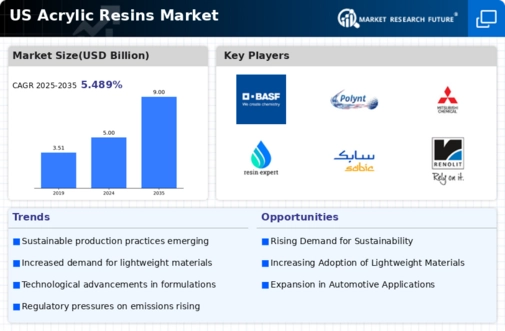The US Acrylic Resins Market has been experiencing a significant evolution, marked by dynamic competition among leading players and new entrants looking to carve out their market share. The landscape is characterized by various application sectors including automotive, construction, electronics, and coatings, driving demand for versatile acrylic resin solutions. As companies seek to innovate and differentiate their products, they are leveraging technology, sustainability initiatives, and customer-centric approaches to gain competitive advantages.
The market also witnesses various strategies including partnerships, mergers, and acquisitions, which further intensify the competitive dynamics, as businesses aim to enhance their operational capabilities and broaden their product offerings to meet the diverse needs of consumers.
BASF maintains a strong foothold in the US Acrylic Resins Market, capitalizing on its extensive product portfolio and robust research and development capabilities. The company's strategic initiatives focus on developing high-performance acrylic resins that cater to multiple application areas, thus enabling them to meet the increasing demand from both domestic and international clients. Strengths such as a well-established distribution network, considerable manufacturing capacity, and a commitment to innovation position BASF favorably in the market.
Their emphasis on sustainability initiatives not only aligns with growing consumer preferences but also enhances their brand reputation, making them a prominent competitor in the acrylic resins segment.
Kraton Corporation is another key player in the US Acrylic Resins Market, known for its expertise in developing innovative adhesive solutions and performance materials. The company emphasizes the production of high-quality acrylic resins used in various applications, including adhesives and sealants, thereby catering to a wide range of industrial needs. With a strategic presence in the US market, Kraton has made notable inroads through its commitment to sustainability and performance features of its products. The company has participated in strategic partnerships and acquisitions aimed at enhancing its technological capabilities and expanding its product offerings, thus reinforcing its competitive edge.
Kraton's focus on customer relationships, expert application knowledge, and strong supply chain logistics further strengthen its position in the acrylic resins market, allowing it to respond effectively to customer demands and market trends.





















Leave a Comment